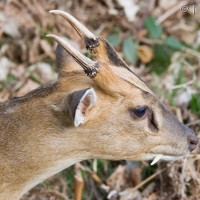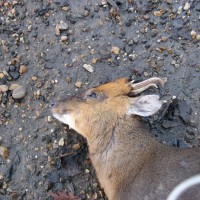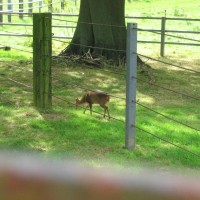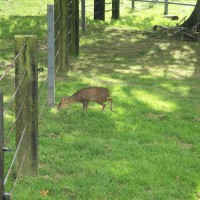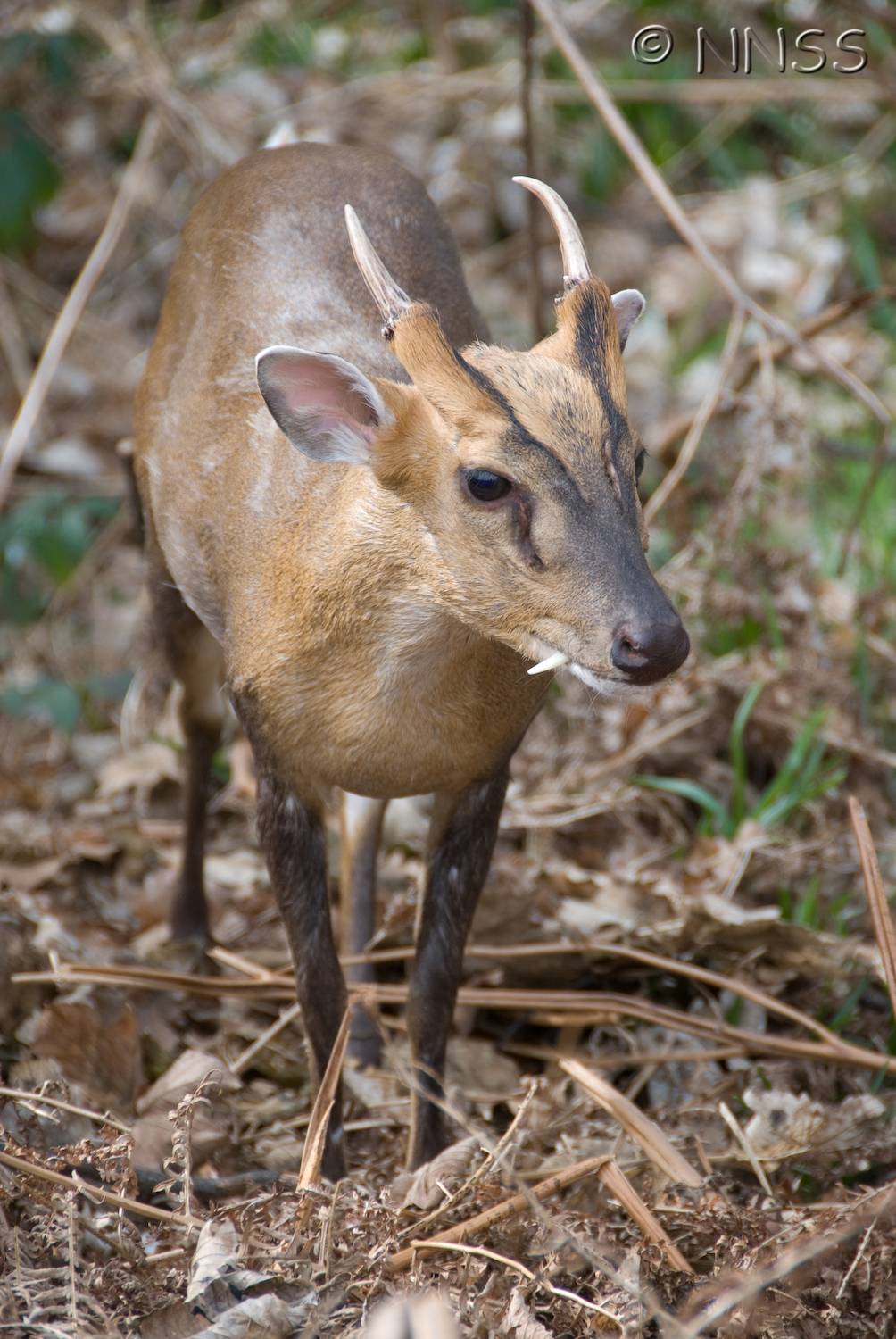
Reeves's Muntjac - Muntiacus reevesi
Expand and collapse the sections below by clicking on the title or + / - icons.
Short description of Muntiacus reevesi, Reeves's Muntjac
This is a small, thickset deer with reddish fur and relatively short legs. When disturbed it shows a conspicuous white underside to the tail. Males have short simple antlers and two blackish lines that run across the forehead towards the snout. Females and young have a blackish pattern on the forehead.
Impact summary: Muntiacus reevesi, Reeves's Muntjac
The arrival of muntjac into English woodlands has severe consequences for their biodiversity, especially in coppices. Muntjac also cause major problems to gardeners and to road traffic.
Habitat summary: Muntiacus reevesi, Reeves's Muntjac
Muntjac are found in a variety of lowland woodland types, preferring a dense understorey and access to arable farmland. They can occur in urban parks and large gardens.
Overview table
| Environment | Terrestrial |
|---|---|
| Species status | Non-Native |
| Native range | China, Taiwan |
| Functional type | Herbivore |
| Status in England | Non-Native |
| Status in Scotland | Non-Native |
| Status in Wales | Non-Native |
| Location of first record | Woburn Park |
| Date of first record | 1894 |
Origin
The native range of this species of muntjac is in the wooded hills of southeast mainland China, Hainan and Taiwan. Some animals were imported to GB from collections in mainland Europe.
First Record
The first zoo imports to GB were in 1838. They were being released into the wild at Woburn Park from around 1894.
Pathway and Method
Muntjac were brought to GB as ornamental animals for parkland estates. They have been subject to many translocations.
Species Status
The main initial centres were Tring (Hertfordshire) and Woburn (Bedfordshire), from where spread has averaged only about 1 km per year. Following many translocations between the 1940s and the 1970s, a faster rate of increase and spread has been evident. Almost half of the 10-km squares in England and Wales had records by the mid 1990s. It is estimated that population size, estimated at 128,500 in 2004, is currently doubling in less than eight years.
Dispersal Mechanisms
The presence of muntjac in GB is due mostly to deliberate release and translocation, although it is possible that some early releases were unintended. Natural rates of spread are apparently slow, and translocation has been an important factor in their dispersal.
Reproduction
Breeding is polygynous and occurs all year. Females may be pregnant almost continuously and give birth to single fawns at intervals as short as 210 days.
Known Predators/Herbivores
Muntjac have no important natural predators in GB. A few fawns may be taken by foxes and some adults by large dogs. They are frequent road casualties, however.
Resistant Stages
None known.
Habitat Occupied in GB
Muntjac feed mainly by browsing and prefer rich foods such as flowers, nuts, berries and fungi. They inhabit a wide range of dense but varied woodland habitats. They are not shy of people and frequently occur in well-wooded parks and gardens and other urban habitats.
The species is now very widespread in eastern England, north to Yorkshire but not including Kent, and westwards to Dorset and into Wales.
Environmental Impact
Muntjac browsing in woodland can clear areas of brambles and other shrubs, and prevent tree regeneration, with profound effects on the structure of the shrub and ground layers and the animals that depend on them for food or shelter, such as birds and butterflies. In conservation woodlands, muntjac can prevent coppice growth, leading to the eventual death of the stools, and overgraze rare plants. High densities of muntjac appear to displace native roe deer from some areas.
Health and Social Impact
Road traffic accidents caused by muntjac are a societal concern.
Economic Impact
Muntjac occasionally browse on growing crops, such as beans, and can cause losses in market gardens, allotments, orchards and vineyards. In forestry, trees often require protection from deer during their early years. Muntjac may destroy expensive ornamental plants and so pose a problem to private and municipal gardeners. Muntjac are reported to cause tens of thousands of road traffic accidents a year in Britain. Some landowners may offset losses from muntjac presence by offering sport shooting.
Identification
Biology, ecology, spread, vectors
Anderson, D. & Cham, S.A. (1987) Muntjac deer (Muntiacus reevesi) – the early years. Bedfordshire Naturalist, 42, 14–18.
Chapman, D.I., Chapman, N.G. & Dansie, O. (1984) The periods of conception and parturition in feral Reeves' muntjac (Muntiacus reevesi) in southern England, based upon age of juvenile animals. Journal of Zoology, London, 204, 575–578.
Chapman, N.G., Claydon, K., Claydon, M. & Harris, S. (1985) Distribution and habitat selection by muntjac and other species of deer in a coniferous forest. Acta Theriologica, 30, 283–303.
Chapman, N., Harris, S. & Stanford, A. (1994) Reeves' muntjac Muntiacus reevesi in Britain: their history, spread, habitat selection, and the role of human intervention in accelerating their dispersal. Mammal Review, 24, 113–160.
Harding, S.P. (1986) Aspects of the ecology and social organisation of the muntjac deer Muntiacus reevesi. DPhil Thesis, University of Oxford.
Management and impact
Putman, R.J. (1997) Deer and road traffic accidents: options for management. Journal of Environmental Management, 51, 43–57.
Putman, R.J. & Moore, N.P. (1998) Impact of deer in lowland Britain on agriculture, forestry and conservation habitats. Mammal Review, 28, 141–164.
Wilson, C. (2003) Current and future deer management options. Report on behalf of Defra European Wildlife Division. full text
General
Harris, S. & Yalden, D.W. (2008) Mammals of the British Isles: Handbook. Fourth edition. The Mammal Society, Southampton.
Lever, C. (2009) The Naturalized Animals of Britain and Ireland. New Holland Publishers, London.
Spotted this species?
Distribution map
View the Distribution map for Reeves's Muntjac, Muntiacus reevesi from NBN Atlas
ID Sheet
ID Sheet for Muntiacus reevsi . See a full list of non-native species ID Sheets.
Risk assessment
Risk assessment for Muntjac deer. See a full list of non-native species Risk assessments.
Legislation
Muntjac Deer, Muntiacus reevesi, is a Species of Special concern. Read more about Non-native species legislation.
Listen to Reeves's Muntjac


